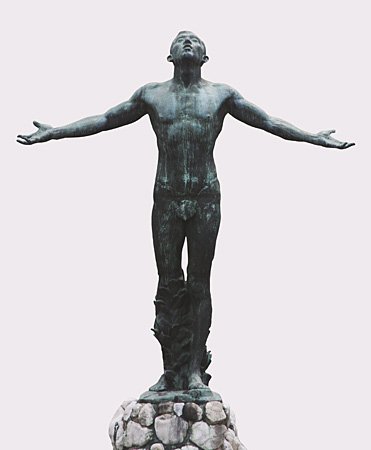Cultural Center of the Philippines
ENCYCLOPEDIA OF
PHILIPPINE ART
Oblation
1935 / Concrete cast / 267.9 x 500.3 x 321.3 centimetres / Artist: Guillermo Tolentino / University of the Philippines (UP) Diliman
The Oblation is the sculpture of a standing, nearly nude young man whose feet are together; upper torso is slightly bent backward; arms are spread to the sides with palms up; fingers are slightly splayed; and the head is tilted back, with eyes closed, mouth slightly agape; and the genitalia covered by a leaf. The Oblation stands on a pedestal of roughhewn rocks from the Marikina River that represents the various islands of the nation’s archipelago. Covering its feet and front legs is a spray of kataka-taka (life plant) leaves, which symbolizes constancy, perseverance, and the spirit of service. The sculpture is done in the Beaux arts style. The identity of the Oblation’s model has been a source of contention. Tolentino himself averred that the sculpture was based on two models—one for the body’s build, and another for the long proportions—but never identified the actual models.
The original concrete cast Oblation was inaugurated on 30 November 1935, and initially stood at the quadrangle of UP Manila. On 11 February 1949, the statue was transferred to UP Diliman and placed in the Oblation Plaza where it remained until the bronze version replaced it. The first bronze Oblation was cast by Tolentino in 1958, based on the plaster mould pulled from the original Oblation statue, which is made of painted reinforced concrete and is currently located in the third floor lobby of the UP Main Library, Gonzalez Hall. The bronze Oblation was commissioned by the UP Golden Jubilee Committee, which appropriated 15,000 pesos for Tolentino to cast the statue at a foundry in northern Italy. The bronze Oblation was unveiled to the public on 29 November 1958 (Cañete 2012, 164). It is located in a landscaped plaza in front of the main administrative building Quezon Hall of UP Diliman. Since then, several bronze works have been done. Anastacio Caedo made three versions for the UP campuses of Manila, Baguio, and Iloilo; Napoleon Abueva made four versions for the UP campuses of Los Baños, Tacloban, Miag-ao, and Davao; and Grace Javier Alfonso made two versions for the UP Open University and Philippine General Hospital. All three artists used casts pulled from the 1935 version. The Oblation at UP Cebu is by Fidel Araneta, who adapted the pose of the 1935 version, but used his own design.
According to Tolentino, the Oblation as the preeminent symbol of UP “stands for truth, and truth is without embellishment at all … the figure of youth standing on the soil of the motherland, his head among the clouds, his arms ready for the stars, is the perfect background of the spirit of sacrifice” (Bacungan 1948, 8). In front of the bronze statue in Oblation Plaza is a 1958 bronze plaque done by Tolentino that contains the Spanish texts from Rizal’s El Filibusterismo (The Reign of Greed)—specifically, Padre Florentino’s words in chapter 39 about the future of the Filipino youth:
Donde esta la juventud que ha de consagrar sus rosadas horas,
Sus ilusiones y entusiasmo al bien de su patria?
Donde esta la que ha de verter generosa su sangre para lavar tantas verguenzas,
Tantos crimenes, tanta abominacion?
Pura y sin mancha ha de ser la victima que el holocausto sea aceptable!
Translation:
Where are the youth who will consecrate their golden hours,
Their illusions and their enthusiasm to the welfare of their native land?
Where are the youth who will generously pour out their blood to wash away so much shame,
So much crime, so much abomination?
Pure and spotless must the victim be that the sacrifice may be acceptable!
(Derbyshire 1912)
For Tolentino, the Oblation is the answer to Padre Florentino’s search for the Filipino youth who is capable of self-sacrifice in the name of nation-building. The Oblation’s meaning is variously associated with sacrifice for the common good and academic freedom. As an icon, the image of the Oblation has been used in Philippine contemporary art, editorial cartoons, and UP’s promotional materials. It has also been appropriated in ritualistic and performative acts such as the Oblation Run held annually in December by members of a student fraternity group. Finally, the Oblation Plaza has also been the preferred site of protest acts concerning various issues in the university and Philippine society.
Written by Santiago A. Pilar (1994) / Updated by Reuben R. Cañete (2018)
Sources
Aguila, Danny. 1949. “Inside UP.” The Philippine Collegian, 1 September, p. 14.
Bacungan, Froilan M. 1948. “The Story of the Oblation.” The Philippine Collegian, 30 November, p. 8.
Cañete, Reuben R. 2012. Sacrificial Bodies: The Oblation and the Political Aesthetics of Masculine Representations in Philippine Visual
Cultures. Quezon City: University of the Philippines Press.
Derbyshire, Charles. 1912. The Reign of Greed: The Complete English Version of El Filibusterismo from the Spanish by Jose Rizal. Manila:
Philippine Education Company.
UP Today. 1967. “The Oblation.” Fourth Quarter, pp. 14-16.
